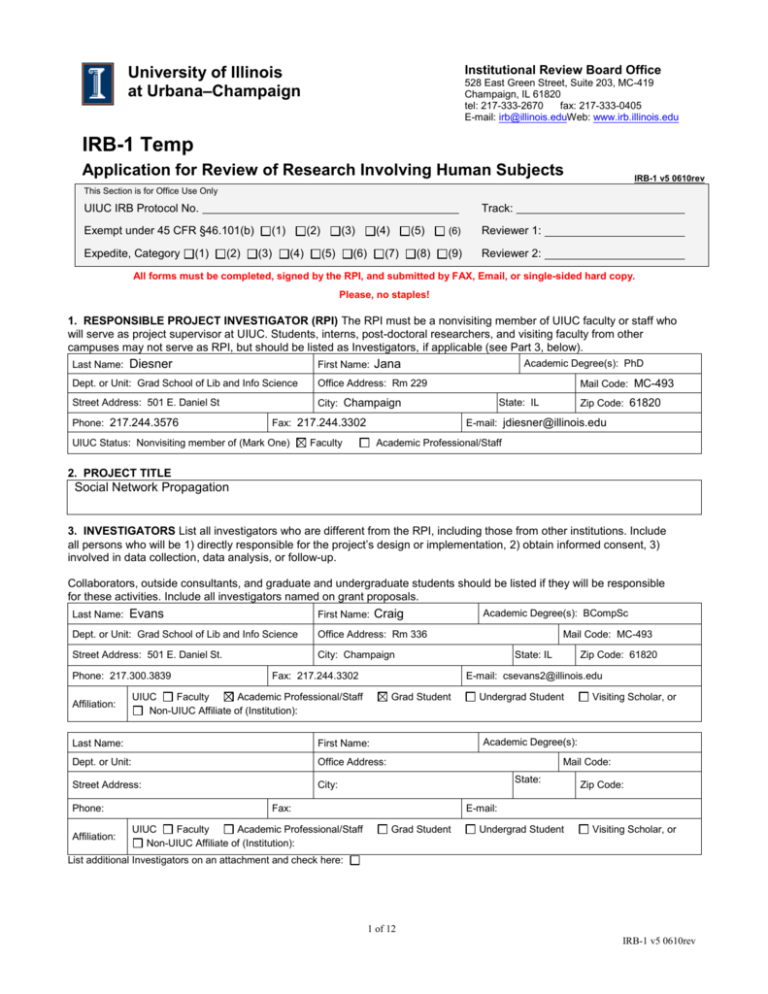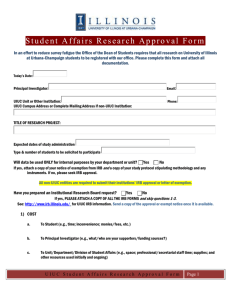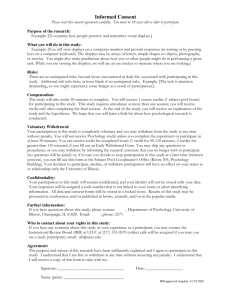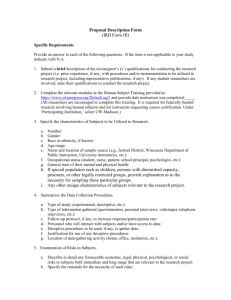IRB 1 Application
advertisement

Institutional Review Board Office University of Illinois at Urbana–Champaign 528 East Green Street, Suite 203, MC-419 Champaign, IL 61820 tel: 217-333-2670 fax: 217-333-0405 E-mail: irb@illinois.eduWeb: www.irb.illinois.edu IRB-1 Temp Application for Review of Research Involving Human Subjects IRB-1 v5 0610rev This Section is for Office Use Only UIUC IRB Protocol No. Track: Exempt under 45 CFR §46.101(b) Expedite, Category (1) (2) (1) (3) (2) (4) (3) (5) (4) (6) (5) (7) (8) (6) Reviewer 1: (9) Reviewer 2: All forms must be completed, signed by the RPI, and submitted by FAX, Email, or single-sided hard copy. Please, no staples! 1. RESPONSIBLE PROJECT INVESTIGATOR (RPI) The RPI must be a nonvisiting member of UIUC faculty or staff who will serve as project supervisor at UIUC. Students, interns, post-doctoral researchers, and visiting faculty from other campuses may not serve as RPI, but should be listed as Investigators, if applicable (see Part 3, below). Last Name: Diesner First Name: Jana Dept. or Unit: Grad School of Lib and Info Science Office Address: Rm 229 Street Address: 501 E. Daniel St City: Champaign Phone: 217.244.3576 Fax: 217.244.3302 UIUC Status: Nonvisiting member of (Mark One) Academic Degree(s): PhD Mail Code: MC-493 Zip Code: 61820 State: IL E-mail: jdiesner@illinois.edu Faculty Academic Professional/Staff 2. PROJECT TITLE Social Network Propagation 3. INVESTIGATORS List all investigators who are different from the RPI, including those from other institutions. Include all persons who will be 1) directly responsible for the project’s design or implementation, 2) obtain informed consent, 3) involved in data collection, data analysis, or follow-up. Collaborators, outside consultants, and graduate and undergraduate students should be listed if they will be responsible for these activities. Include all investigators named on grant proposals. Last Name: Evans First Name: Craig Dept. or Unit: Grad School of Lib and Info Science Office Address: Rm 336 Street Address: 501 E. Daniel St. City: Champaign Phone: 217.300.3839 Affiliation: Fax: 217.244.3302 UIUC Faculty Academic Professional/Staff Non-UIUC Affiliate of (Institution): Grad Student First Name: Dept. or Unit: Office Address: Street Address: City: Affiliation: State: IL Zip Code: 61820 Undergrad Student Visiting Scholar, or Academic Degree(s): Mail Code: State: Fax: UIUC Faculty Academic Professional/Staff Non-UIUC Affiliate of (Institution): Mail Code: MC-493 E-mail: csevans2@illinois.edu Last Name: Phone: Academic Degree(s): BCompSc Zip Code: E-mail: Grad Student Undergrad Student Visiting Scholar, or List additional Investigators on an attachment and check here: 1 of 12 IRB-1 v5 0610rev 4. RESEARCH STAFF. List other research personnel who should be copied on IRB Office correspondence for this study. Last Name: First Name: Dept. or Unit: Office Address: Street Address: City: Phone: Academic Degree(s): Mail Code: State: Fax: E-mail: UIUC Faculty Academic Professional/Staff Non-UIUC Affiliate of (Institution): Affiliation: Zip Code: Grad Student Undergrad Student Visiting Scholar, or List additional Research Staff on an attachment and check here: 5. FUNDING Indicate whether this research is funded by, or application has been made for, a grant, contract, or gift. 5A. STATUS Research is not funded and is not pending a funding decision (Proceed to Part 6). Research is funded (funding decision has been made). Funding decision is pending. Funding proposal submission date: 5B. SOURCE(S) If the research is funded or pending a funding decision, mark and name all sources: Type of Funding—check all that apply UIUC Department, College, or Campus Name of Source (includes Research Board and Campus Fellowship Training Grants) Federal (from federal agencies, offices, departments, centers) Commercial Sponsorship (from corporations, partnerships, proprietorships) State of Illinois Department or Agency (from any state office or entity) Gift or Foundation (including UIF) (public or private foundations, not-for-profit corporations, private gifts) Check here if the funding is through a Training Grant: 5C. PROPOSAL Attach a complete copy of the funding proposal or contract. Attached Sponsor-assigned grant number, if known: Title of Funding Proposal or Contract, if different from Project Title in Part 2: 5D. FUNDING AGENCY OFFICIAL, IF ANY, TO BE NOTIFIED OF IRB APPROVAL Last Name: First Name: Agency: Office Address: Street Address: Phone: Salutation: Mail Code: City: State: Fax: Zip Code: E-mail: 6. FINANCIAL INTERESTS: Indicate below if any investigators or any members of their immediate families have any relationships, commitments, or activities with the sponsor of this research that might present or appear to present a conflict of interest with regard to the outcome of the research. (If a financial conflict of interest exists, please submit the UIUC approved conflict management plan. If you have questions about conflict of interest contact the Office of the Vice Chancellor for Research at 217-333-0034.) Ownership, equity or stock options Has been disclosed to the UIUC campus OR has not been disclosed to the UIUC campus Personal compensation such as royalties, consulting fees etc. Has been disclosed to the UIUC campus OR has not been disclosed to the UIUC campus Intellectual property such as patents, trademarks, copyright, licensing, etc. Has been disclosed to the UIUC campus OR has not been disclosed to the UIUC campus Other conflict of interest: Has been disclosed to the UIUC campus OR has not been disclosed to the UIUC campus No conflicts exist 2 of 12 IRB-1 v5 0610rev 7. SUMMARIZE THE RESEARCH. In LAY LANGUAGE, summarize the objectives and significance of the research. The term “six degrees of separation” has become common based on a study performed by Stanley Milgram published in 1967 (“The Small World Problem”) in which he postulated that everyone is connected to everyone else on average by 6 people. Using Facebook (www.facebook.com) as a platform, I plan to simulate the spread of a virus through a network of socially connected communities. The “virus” will be in the form of a Facebook application that a user receives, and then forwards onto people within their Facebook social network (friends list) to illustrate the “Small World” connections in Facebook. As the application is forwarded, the following data will be collected: a unique identifier of the person sending the message, the persons location (as reported in their “hometown” field – requires a user to “opt in” to allow access), gender, age (if allowed – this is an “opt in” disclosure field in Facebook), a unique identifier for each friend the application was sent to, and a date/time stamp of when the message was transmitted From this information, the spread of the application through Facebook will be monitored, and a network map constructed showing the connections (person to person), locations (geographic spread) of the application, and time taken to propagate throughout Facebook. Additional details including gender and age will be used for analysis of results to determine if a particular demographic was more inclined to participate than others. 8. PERFORMANCE SITES Including UIUC sites, describe ALL the research sites for this protocol. For each non-UIUC site, describe: Whether the site has an IRB. Whether the site has granted permission for the research to be conducted. Contact information for the site. If the site has an IRB, whether the site’s IRB has approved the research or planned to defer review to a UIUC IRB. For non-UIUC sites, documentation of IRB approval is: 1. Internet Attached Will Follow N/A 2. Attached Will Follow N/A 3. Attached Will Follow N/A List and describe any additional Performance Sites information on an attachment and check here: 9. DESCRIBE THE HUMAN SUBJECTS 9A. SECONDARY DATA ONLY? If this research only involves the analysis of data that has already been collected from human subjects and no new data collection will occur, check here: 9B. MATERIALS OF HUMAN ORIGIN? Will this research involve the collection, analysis, or banking of human biological materials (e.g., cells, tissues, fluids, DNA)? Yes No If yes attach Appendix C, the Biological Materials Form. 9C. ANTICIPATED NUMBERS How many subjects, including controls, will you study in order to get the data that you need? If you plan to study disproportionate numbers of a given sex, race, or minority group, provide scientific rationale in Part 11. Performance Site # Male # Female Total 1. Internet – gender and race neutral. Unknown 2. 3. TOTALS List Anticipated Numbers for additional Performance Sites on an attachment and check here: 9D. AGE RANGE Mark all that apply. Researchers planning to include children in research projects involving more than minimal risk must provide written documentation of the benefits that are likely to accrue to a child participating in the project. This should include information gathered on adults, if it exists, or an explanation about why it does not exist. 0–7 years 8–17 years 18–64 years 65+ years If applicable, written documentation of benefits for including children in more than minimal risk research is attached. While children may be included in the study, their inclusion does not fall under the more than minimal risk guidelines. Facebook Terms of Service state that children should be older than 13 to have an account. 3 of 12 IRB-1 v5 0610rev 9E. SPECIAL OR VULNERABLE POPULATIONS Mark groups that will be targeted by design. Also indicate groups likely to be involved in the research even though they are not targeted by design. None of the following special populations will be targeted Children (age < 18 years) Neonates Mentally disabled or cognitively impaired persons Fetuses (in utero) Adults with legal guardians in vitro fertilization subjects Persons with limited civil freedom (e.g., members of military) Pregnant or lactating women Specific racial or ethnic group(s)— describe: Inpatients Low income or economically disadvantaged persons Outpatients UIUC Students—name subject pool, if applicable: Elderly (age > 65 years) Other College Students—name subject pool, if applicable: Other (describe here): 9F. If you checked any of the groups in question 9E, describe additional safeguards included in the protocol to protect the rights and welfare of special or vulnerable populations. As a study of internet (Facebook) users, I have no direct control over the population participating in the study. The information being gathered is minimal and except for gender and hometown information is publicly available through the Facebook developer interfaces. For the purposes of this study, user names will not be stored, instead an anonymised (SHA1 one-way hashed) version of their numeric user id will be used. 10. RECRUITMENT 10A-1 RECRUITING PROCEDURES Specifically describe the systematic procedures for finding and recruiting subjects or requesting pre-existing data or materials. 1) State whether any of the researchers are associated with the subjects (e.g., subjects are students, employees, patients). 2) Name any specific agencies or institutions that will provide access to subjects or subject data. 3) Who will contact the prospective subjects? 4) Who gives approval if subjects are chosen from records? 5) Describe solicitation through the use of advertising (e.g., posters, flyers, announcements, newspaper, radio, television, Internet), face-to-face interaction, direct mail or phone contact, classrooms, subject pools, health care registries, patient referrals, and institutional “gatekeepers,” as applicable. Subjects being studied will all have an initial connection with the Investigator (Craig Evans). From that point on, participating subjects will be based upon the friends lists in the receivers Facebook page. 1. Initial subject pool will be known to the Investigator in a social, non professional context. 2. No specific agencies or institutions will be providing data. 3. Prospective subjects will be contacted by referral from a previous participant 4. N/A 5. Advertising will be via a Facebook page. No paid advertising will be used or solicited. 10 A-2 Attach final copies of recruiting materials including the final copy of printed advertisements and the final version of any audio/taped taped advertisements and check here: Attached Will Follow 10B. WITHHELD INFORMATION Do you propose to withhold information from subjects prior to or during their participation? Yes No If yes, describe what will be withheld, justify the withholding (address risks, provide rationale), describe the debriefing plan, and attach a labeled copy of a written debriefing form, to be provided to subjects. Debriefing Attached Will Follow 4 of 12 IRB-1 v5 0610rev 10C. PROTECTED HEALTH INFORMATION (PHI) The IRB must address the privacy and use of health information that is created, received, or housed by health care providers, health plans, or health care clearinghouses and that identifies or could be used to identify an individual. During either recruiting or data collection, will you use or have access to such information that is related to the past, present or future health or conditions of a living or deceased individual, provision of health care to the individual, or the payment for the provision of health care to the individual? Yes No 10D. SCHOOLS-BASED RESEARCH If subjects will be recruited from Illinois public or private elementary or secondary schools, additional deadlines and procedures apply. Criminal background clearances might be required. Special consideration must be given to the exclusion of protected populations. Please contact the Office of School–University Research Relations (OSURR) (217.244.0515 or http://www.ed.uiuc.edu/BER/OSURR.html) for more information. Mark one: Illinois schools will be used Illinois schools will not be used 11. INCLUSION AND EXCLUSION CRITERIA Address all four of the following items in explaining who will and will not qualify for participation and how that determination will be made: (1) Describe procedures to assure equitable selection of subjects. Justify the use of any special or vulnerable groups marked in Part 9E. Selection criteria that target one sex, race, or ethnic group require a clear scientific rationale. (2) List specific criteria for inclusion and exclusion of subjects in the study, including treatment groups and controls. (3) Name and attach copies of measures and protocols that will be used to screen applicants. (4) Explain how the inclusion/exclusion criteria will be assessed and by whom. If special expertise is required to evaluate screening responses or data, tell who will make this evaluation and describe their training and experience. 1. 2. 3. 4. Subjects are not being targeted by race, gender, or ethnic group. Gender is recorded for informational purposes only, and is not a targeted qualification criteria. No inclusion/exclusion criteria specified. Participation is voluntary, and based on referral from a previous participant. No screening will be taking place. No inclusion/exclusion criteria being assessed. 12. RESEARCH PROCEDURES: Using LAYMAN’S LANGUAGE, specifically describe what the participants (treatment groups and controls) will do and where the research activities will take place. Give approximate dates and durations for specific activities, including the total number of treatments, visits, or meetings required and the total time commitment. (For schools-based research where class time is used, describe in detail the activities planned for nonparticipants and explain where (e.g., in a classroom, in a private area) both participants and nonparticipants will be located during the research activities. Include a concise description of procedures, locations, time commitments, and alternate activities on the relevant consent and assent forms.) 5 of 12 IRB-1 v5 0610rev Facebook users who choose to participate in the study will be given the option to forward an application invitation to members of their friends list. To participate fully, a user will allow access to their birthdate and hometown fields in Facebook. Those choosing not to disclose this information (and those who do not have it available) will be recorded with a “null” data element. Once the opt-in questions (hometown and age) have been answered, the users will select the friends to send the application invite to, and submit the message. Location: Internet Study Duration: Approx 4 weeks, commencing late October (pending approval). Time Required for each participant: <2 minutes. Number of session per participant: 1. 13. EQUIPMENT Will any physical stimulation or physiological data acquisition equipment be used with the subjects? Yes No If yes, attach Appendix A, the Research Equipment Form. 14. DEVICES Will any devices be used with the subjects? Yes No If yes, attach Appendix B-1. 15. DRUGS AND BIOLOGICS Will any drugs or chemical or biological agents be used with the subjects? Yes No If yes, attach Appendix B-2. 15. MRI AT BIC To use the Beckman Institute Biomedical Imaging Center (BIC) in human subject’s research, you must obtain prior approval from the BIC (217.244.0600; bmrf@bmrl.bmrf.uiuc.edu) and use BIC-approved screening and consent forms. Attach: BIC approval Attached BIC screening form Attached BIC consent form Attached 16. MEASURES If subjects will complete questionnaires, surveys, interviews, psychological measures, or other measures, however administered, the IRB must review and approve the measures. List all such measures here and attach complete, labeled copies (including translations, if applicable) to this application: Measure 1: Generated data metrics from Facebook Application Attached Will Follow Measure 2: Attached Will Follow Measure 3: Attached Will Follow Measure 4: Attached Will Follow List additional Measures on an attachment and check here: 17. SUBJECT REMUNERATION Will subjects receive inducements or rewards before, during, or after participation? Yes No If yes, will payment be prorated for partial participation? Yes No If remuneration will be given, for each subject group: (1) specify the form of remuneration, including $, course credit, lottery, gift certificate, or other; (2) state the $ amount or the approximate $US value, or the course credit and its percentage of the final grade; (3) explain the remuneration plan, including whether and how prorating will be made for partial participation; (4) for lotteries, include (a) the number of prizes, (b) the nature and value of each prize, (c) the approximate odds of winning, (d) the date(s) of the drawing(s), and (e) how winners will be notified, by whom, and by when; and (5) include all this information on the relevant consent forms. 6 of 12 IRB-1 v5 0610rev 18. SUBJECT OUTLAY Will subjects incur costs for research-related procedures (e.g., longer hospitalization, extra tests), use of equipment, lost compensation, or transportation (over 50 miles)? Yes No If yes, describe here: Minimal – approximately 2 minutes of time on their own personal computer via an internet connection. 19. CONFIDENTIALITY OF DATA Answer each of the following to describe methods that will ensure the confidentiality of individually identifiable data. Confidentiality is required unless subjects give express, written permission to have their identifiable information published, presented, or shared. 19A. CHECK IF USED IN DATA COLLECTION: Audio tapes/ Digital voice Video tapes Still photos Other imaging 19B. DATA COLLECTION Explain how the data will be collected. If anonymous data collection is proposed, provide details of how investigators will not have the ability to trace responses to subject identities. For multiphase data collection or if multiple contacts will be made with subjects, specifically explain the subject tracking and coding systems. Address the confidentiality of data collected via e-mail, databases, Web interfaces, computer servers, and other networked information, as applicable. Data will be collected from a Facebook application (essentially a web interface), and transmitted to a secure webserver. Users will be anonymised via a one way hashing algorithm that takes their Facebook user id (a numeric value) and anonymises it. Gender (and opt-in details such as age and home town location) will be stored against the anonymised user id. 19C. DATA SECURITY Describe how and where the data be kept so that the data remain confidential. Data will be stored in a password secured database for the duration of the project, and archived to recordable media at the completion of the study. Access to the database will be restricted to write only access for users, and read write access for the Investigators. 19D. STAFF TRAINING Describe the training and experience of all persons who will collect or have access to the data. 7 of 12 IRB-1 v5 0610rev This project is part of the ongoing doctoral studies of Craig Evans, specifically for his graduate class – LIS590SF Social Computing. As such it forms part of his training and experience development. Mr Evans has however worked in the area of health and personal insurance and is experienced in HIPAA data usage guidelines. 19E. DATA RETENTION How long will the data be kept? Data will be kept online for the duration of the study, after which it will be archived to recordable media. 19F. DISSEMINATION OF RESULTS What is(are) the proposed form(s) of dissemination (e.g., journal article, thesis or academic paper, conference presentation, sharing within industry or profession)? Results will be disseminated via a publicly accessible web page during the data gathering process, and via an academic paper (format and venue to be determined) once the study is complete. 19G. PRIVACY Describe provisions to protect the privacy interests of subjects. Data will be anonymised, and discussed in aggregated forms. 19H. INDIVIDUALLY IDENTIFIABLE INFORMATION Will any individually identifiable information, including images of subjects, be published, shared, or otherwise disseminated? Yes No If yes, subjects must provide explicit consent or assent for such dissemination. Provide appropriate options on the relevant consent documents. 20. INFORMED CONSENT: University policy requires the execution of a comprehensive, written document that is signed by the subject (or the subject’s authorized representative) as the principal method for obtaining consent from subjects. The language in the document must be understandable to the subject or the subject’s legally authorized representative. An investigator may request a Waiver or Alteration of Informed Consent or a Waiver of Documentation of Informed Consent (e.g., online consent, oral consent). If requesting a waiver please complete the appropriate waiver form at: www.irb.illinois.edu and submit it with the IRB Application for review. Children must assent (or, voluntarily agree) to participation and a parent must separately consent on behalf of their child (i.e., two different forms are generally required). Children under age 8 may assent either orally or passively, depending on their level of maturity. Children 8–17 years old should sign a written form unless the UIUC IRB approves a different process. 20A. TYPE OF CONSENT Check all that apply and attach one copy of each relevant form, letter, or script on university letterhead. Include translations, if consent will be obtained in a foreign language. Use headings, headers, or footers to uniquely identify each document and associate it with the subject group for which it will be used. 8 of 12 IRB-1 v5 0610rev Written informed consent (assent) with a document signed by adult subjects parent(s) or guardian(s) adolescents aged 8–17 years Waiver or Alteration of Informed Consent (Attach waiver form.) adult subjects parent(s) or guardian(s) adolescents aged 8–17 years Waiver of Documentation (signature) of Informed Consent (Attach waiver form.) adult subjects parent(s) or guardian(s) adolescents aged 8–17 years 20B. USE OF PROXY Will others (e.g., next of kin, legal guardians, powers of attorney) act on behalf of adult subjects in giving consent to participate in this research? Yes No if yes, describe in Section 20D. 20C. USE OF PROXY OUTSIDE THE UNITED STATES If a proxy is used in research conducted outside Illinois, provide justification (e.g., statement of an attorney or copy of applicable law) that the proxy is authorized under the laws of the jurisdiction in which the research will be conducted to consent to the procedures involved in this protocol. 20D. CONSENT PROCESS Describe when and where voluntary consent will be obtained, how often, by whom, and from whom. If cognitively impaired subjects (including children under age 8) will be involved, explain how the subject’s understanding will be assessed and how often; include the questions that will be asked or actions that will be taken to assess understanding. Describe any waiting period between informing the prospective subject and obtaining the consent. Describe steps taken to minimize the possibility of coercion or undue influence. Indicate the language used by those obtaining consent. Indicate the language understood by the prospective subject or the legally authorized representative. If the research involves pregnant women, fetuses, or neonates, indicate whether consent will be obtained from the mother, father, or both. If the research involves children, indicate whether consent will be obtained from: Both parents unless one parent is deceased, unknown, incompetent, or not reasonably available, or when only one parent has legal responsibility for the care and custody of the child; or from one parent regardless of the status of the other parent. 21. RISKS 21A. DESCRIPTION Specifically describe all known risks to the subjects for the activities proposed and describe the steps that will be taken to minimize the risks. Include any risks to the subject’s physical well-being, privacy, dignity, self-respect, psyche, emotions, reputation, employability, and criminal and legal status. Risks must be described on consent forms. 9 of 12 IRB-1 v5 0610rev 21B. RISK LEVEL: No more than minimal risk (the probability and magnitude of harm or discomfort anticipated for participation in the proposed research are not greater in and of themselves than those ordinarily encountered in daily life or during the performance of routine physical or psychological examinations or tests). More than minimal risk 21C. Data Monitoring Plan: If you checked that the research is more than minimal risk, describe the provisions for monitoring the data to ensure the safety of subjects (Who will periodically monitor harms and benefits experienced by subjects to ensure that the relationship of risks to potential benefits remains unchanged? How often will monitoring occur? What analyses will be performed? If appropriate, what criteria will be used to stop the research based on monitoring of the results?) 22. BENEFITS Describe the expected benefits of the research to the subjects and/or to society. 23. RISK/BENEFIT ASSESSMENT Weigh the risks with regard to the benefits. Provide evidence that benefits outweigh risks. 10 of 12 IRB-1 v5 0610rev If additional Risk/Benefit information is attached, check here: 24. Is this a multi-center study in which the UIUC investigator is the lead investigator of a multicenter study, or the UIUC is the lead site in a multi-center study. Yes No If yes, describe the management and communication of information obtained that might be relevant to the protection of subjects, such as: unanticipated problems involving risks to subjects or others, interim results and protocol modifications. 11 of 12 IRB-1 v5 0610rev 25. INVESTIGATOR ASSURANCES: The signature of the Responsible Project Investigator is required (scanned or faxed signatures are acceptable). Other investigators are also responsible for these assurances and are encouraged to sign. I certify that the information provided in this application, and in all attachments, is complete and correct. I understand that I have ultimate responsibility for the protection of the rights and welfare of human subjects, the conduct of this study, and the ethical performance of this project. I agree to comply with all UIUC policies and procedures, the terms of its Federal Wide Assurance, and all applicable federal, state, and local laws regarding the protection of human subjects in research. I certify that the project will be performed by qualified personnel according to the UIUC IRB-approved protocol. the equipment, facilities, and procedures to be used in this research meet recognized standards for safety. no change will be made to the human subjects protocol or consent form(s) until approved by the UIUC IRB. legally effective informed consent or assent will be obtained from human subjects as required. Unanticipated problems, adverse events, and new information that may affect the risk–benefit assessment for this research will be reported to the UIUC IRB Office (217.333.2670; irb@illinois.edu) and to my Departmental Executive Officer. I am familiar with the latest edition of the UIUC Handbook for Investigators, available at www.irb.illinois.edu, and I will adhere to the policies and procedures explained therein. student and guest investigators on this project are knowledgeable about the regulations and policies governing this research. I agree to meet with the investigator(s), if different from myself, on a regular basis to monitor study progress. if I will be unavailable, as when on sabbatical or other leave, including vacation, I will arrange for an alternate faculty sponsor to assume responsibility during my absence. I will advise the UIUC IRB by letter of such arrangements. I further certify that the proposed research has not yet been done, is not currently underway, and will not begin until IRB approval has been obtained. Responsible Principal Investigator Date Investigator Date Investigator Date Investigator Date 25. (OPTIONAL) DEPARTMENTAL ASSURANCE To be completed by the RPI’s Departmental Executive Officer or their designee. The activity described herein is in conformity with the standards set by our department and I assure that the principal investigator has met all departmental requirements for review and approval of this research. Departmental Executive Officer (or designee) * Date For units that conduct scientific merit review, the signature above documents the following: 1. The research uses procedures consistent with sound research design. 2. The research design is sound enough to yield the expected knowledge. 12 of 12 IRB-1 v5 0610rev






